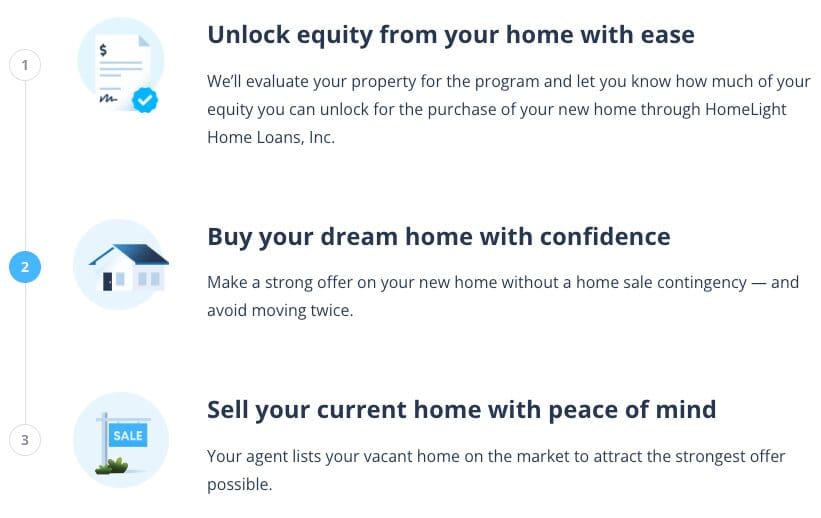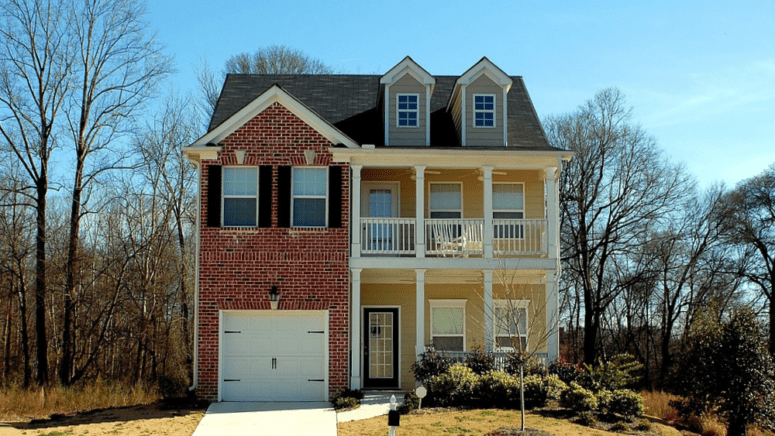I Want to Buy a New House. Do I Have to Get a Bridge Loan?
- Published on
- 10 min read
-
 Amy Pawlukiewicz, Contributing AuthorClose
Amy Pawlukiewicz, Contributing AuthorClose Amy Pawlukiewicz Contributing Author
Amy Pawlukiewicz Contributing AuthorAmy Pawlukiewicz is a writer and editor with over 15 years of experience in her field. She has a B.A. in English from Kenyon College and currently resides in Los Angeles.
-
 Alexandra Lee, Associate EditorClose
Alexandra Lee, Associate EditorClose Alexandra Lee Associate Editor
Alexandra Lee Associate EditorAlexandra is an associate editor of HomeLight.com. Previously, she served as a writer and social media manager at Santa Barbara Life & Style Magazine, in addition to interning at the nonprofit honors society Phi Beta Kappa. Alexandra holds a bachelor's degree in communication and global studies from UC Santa Barbara, and she has three years of experience reporting on topics including international travel, luxury properties, celebrity interviews, fine dining, and more.
You wake up one morning and realize you’re facing a similar situation as a lot of other people — your family has expanded, but your house has stayed the same size. Kind of like in Alice in Wonderland, when Alice eats the cookie in the White Rabbit’s house and grows until she’s bursting out of it. Time to move!
But you have a problem: Without a ton of cash in the bank, you won’t have the funds to buy a new house until you sell your current one. There has to be a way out of this, right?
There is. And you’re not alone — when financing a home purchase, 53% of repeat buyers reported using funds from the sale of a primary residence to upgrade to their new home. There are a few different solutions, and one of those is a bridge loan.
A bridge loan is probably the best-known method for getting the rates and terms on the mortgage that you want without having to sell your current house first. Best of all — if you’ve found your next dream home, you don’t have to convince the seller to wait until you’ve sold your current home. But there are some drawbacks, and possibly a better option out there for you than a bridge loan. Here’s what you need to know.
How bridge loans work
Bridge loans are short-term loans secured with your existing home’s equity; you can then use the funds as a down payment for the house you’re looking to buy.
Short-term is the key here: bridge loans typically have terms between six months and a year. They are intended to be repaid as soon as you sell your current home, and they are also referred to as interim loans, gap financing, or “swing” loans.
The idea behind bridge loans is that they “bridge” the gap between when a homebuyer needs money and when they have it in the bank. You could think of these loans kind of like payday loans, only with a more forgiving interest rate.
However, because of their short-term nature and the risk factor, interest rates on bridge loans tend to be higher than mortgages. You’ll also likely have to pay an origination fee.
Typically, a bridge loan is paid off in one lump sum or “balloon payment,” either as soon as the funds from the sale of the current house are available, or at the end of the loan term. “You can tap the equity of your current home before you’ve sold it,” explains top-selling Omaha agent Don Keeton, who works with 75% more single family homes than the average agent in his area.
Here are three examples of how a bridge loan could work. (Note: These are simply hypotheticals to illustrate how the bridge loan could work and don’t take into account the interest payments and fees you would pay on an actual bridge loan.)
Example #1: Say your current home is worth $200,000, and you have $100,000 in equity. You find a home that you want to buy that costs $300,000, and you want to put down $60,000, or 20% — but you don’t have any savings, and you haven’t sold your home yet. You can take out a bridge loan for $60,000 and buy your new house. Then, when your old house sells, you can use the $100,000 you make from the sale (minus your fees for selling a house — closing costs, interest) to pay off the bridge loan. You should also have some money left over since you didn’t use the entire $100,000 to pay off the bridge.
Example #2: Your current home is worth $300,000, and you have $90,000 in equity. Your new home costs $450,000, and you want to put down 20%, or $90,000. That’s the full amount of your equity — but you really want this house. You can take out a bridge loan for the full down payment amount of $90,000. When your old house sells, you use the proceeds to pay back the $90,000 bridge loan. The only difference in this scenario is that you wouldn’t have money left over from the proceeds since you used all of your equity to buy the new house … in fact, with the interest you’ll have to pay on the bridge loan, you’ll owe money at the end of the day.
Example #3: Your current home is worth $120,000 and you have $72,000 in equity. The new home you’ve found costs $250,000. A 20% down payment is $50,000, which should be no problem with $72,000 in equity available. You take out a bridge loan for $50,000 to purchase the new house. When the old house sells, you pay off the bridge loan for $50,000 and are left with $22,000 from the equity in your old home (minus your expenses — closing costs, interest, and fees).
Starting to make sense?
“If you go to a seller and say, ‘Would you wait until I sell my house?’, in today’s market, they’ll probably say ‘No,’” says Keeton. “A bridge loan is a way for you to take control of that house so you don’t lose it to another buyer.”
Pros of bridge loans
Aside from being able to secure the home you want when you want it, there are other perks to bridge loans.
Interest rates
If interest rates are low when you get the bridge loan and you’re ready to buy your new house right away, then you can lock in that low rate on your new home’s mortgage without waiting for your existing place to sell.
Multiple moves
Moving is one of the most stressful life events; who wants to go through it twice? “Sometimes what you have to do is sell your house, move to an apartment, buy another house, and then move again. A bridge loan helps avoid that,” explains Keeton.
With a bridge loan, you can buy your next home and move immediately. If you have to wait to sell your current home before buying your next home, there’s a chance you’ll end up having to move into a temporary spot and put your stuff in storage. That’s just an extra headache.
Speed
Because bridge loans are secured with real estate, they usually get approved and funded very quickly.
Appeal
Having a bridge loan can make your offer more attractive to a seller; it is one less sales contingency they have to worry about.
You can get one while your house is for sale
Unlike a home equity loan or a home equity line of credit (HELOC), you can secure a bridge loan while your house is on the market.
Cons of bridge loans
As appealing as bridge loans may sound, there are some negative factors to consider.
Interest rates
Interest rates on bridge loans are usually high — even higher than home equity loans or HELOCs.
Double mortgage
If your old house doesn’t sell right away, you’re stuck paying two mortgages until it sells. While sometimes this isn’t a huge issue, if you run into trouble selling your house, it could be a financial disaster.
Credit score
In order to secure a bridge loan, you need to have good credit and a low debt-to-income ratio; there is little wiggle room here.
Fees
Most bridge loans come with origination fees such as administration fees, escrow fees, wiring fees, notary fees, and title policy fees. Those fees can be high and are usually a percentage of the loan.
Appraisal
In order to determine the value of your current home, a lender will require an appraisal. Appraisals typically run between $313 and $423, and you’ll have to foot the bill.
Equity
Lenders usually require that a homeowner has at least 20% equity built up in their home before they will consider extending a bridge loan.
Default
If your current house doesn’t sell, you still have to pay the bridge loan. That means you’re on the hook for three payments: your current home, your new home, and your bridge loan. Having these three huge financial obligations increases your likelihood of defaulting on one of those loans.
Other options
So, are there alternatives to bridge loans? Sure!
A home equity loan is one option to avoid a bridge loan. Interest rates on home equity loans are lower than bridge loans, and if you already have a home equity line of credit available, the funds are at the ready.
“Let’s say you see the deal of the century. If you have a home equity loan with $100,000 available and don’t have any funds drawn, you could write a check right then,” Keeton points out.
But, you’re still on the hook for three loans if your house doesn’t sell. Also, if your home is already up for sale, you can’t get a home equity loan.
How to unlock home equity to buy before you sell
If you are a homeowner considering equity financing to purchase a new home in order to sidestep the buy-sell timing conundrum, there is a modern way to buy before you sell.
HomeLight’s Buy Before Your Sell program makes it easy to use the equity from your current home to make a strong, less contingent offer on a new home. Our innovative program, with its near-instant Equity Unlock Calculator, lets you streamline and simplify the entire buying and selling process.
Here’s how HomeLight Buy Before You Sell works:

If your home qualifies, you can get your equity unlock amount approved in 24 hours or less. No cost or commitment is required. Once approved, you can buy your next home with confidence and then sell your current home with peace of mind.
Is a home equity loan right for me?
Determining whether a home equity loan is right for you depends on your financial situation. The key is to consider the costs involved, your long-term financial plans, and how comfortably you can manage the additional debt without risking your home.
If you’re considering a home equity loan to purchase a second property, HomeLight can connect you with a top real estate agent in your market who can provide expert guidance and insights.
Trying to move up from your current home into a new home can be stressful, especially if you don’t have a ton of cash in the bank. But you don’t have to worry — there are options to help you buy your (next) dream home.
Header Image Source: (paulbr75/ Pixabay)




